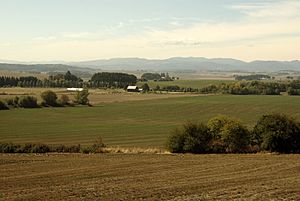Treaty with the Kalapuya, etc. facts for kids
The Kalapuya Treaty, also known as the Treaty of Dayton, was an important agreement signed in 1855. It was made between the United States government and several Native American tribes. These included the Kalapuya, Molala, and Clackamas tribes, along with others living in the Oregon Territory. Through this treaty, the tribes were forced to give up their land. In return, they were promised a permanent reservation, money, supplies, education, health care, and protection from settlers.
This treaty effectively gave the entire Willamette Valley to the United States. It removed Native American groups who had lived in the area for over 10,000 years. The treaty was signed on January 22, 1855, in Dayton, Oregon. It became official on April 10, 1855. This treaty is different from the Treaty with the Umpqua and Kalapuya of 1854.
Contents
Why the Treaty Happened
In the 1830s, many people in the United States believed in something called "Manifest Destiny". This was the idea that the United States should expand and control all of North America. This belief encouraged American settlers to move west into the Oregon Territory. The Oregon Trail helped many more people move there in the early 1840s.
The Oregon Territory included parts of modern-day Oregon, Washington, Idaho, Montana, and British Columbia. Unlike California, which was controlled by Mexico, the Oregon lands were not strongly claimed by any European country or the U.S. at first.
Impact on Native Americans
Starting in the late 1700s, European and American explorers brought new diseases. These diseases caused terrible sicknesses that greatly reduced the number of Native Americans living in the region. By the 1850s, the remaining Native people had few choices. They faced more harassment and their land was taken by settlers. These settlers believed the United States should reach all the way to the Pacific Ocean.
Many early American settlers moved to the Willamette Valley. This was a very fertile area with the Willamette River running through it. Kalapuyan tribes had lived there for over 10,000 years. The Americans were not the first white settlers there. A group of French Canadians, who used to work for the Hudson's Bay Company, had already settled in the French Prairie area.
The American settlers quickly asked the U.S. government to officially claim the area. They wanted protection from both the Native residents and the British. In 1846, the United States and Great Britain signed the Oregon Treaty. This treaty divided the Oregon Territory in half. It did not consider the Native peoples who lived on the land. After this, the Willamette Valley became part of the U.S. Oregon Territory. However, the local tribes had not yet agreed to give up their land.
The Treaty Agreement
In 1850, the U.S. Congress sent its first group to make treaties with Native Americans in the region. Within a year, they made agreements with the Santiam, Tualatin, Yamhill, and Luckiamute bands of the Kalapuya. These groups were forced to give up their lands. In return, they were to live on special reservations. But Congress stopped this group's work before it was finished. So, these first treaties were never officially approved.
Native Americans continued to have conflicts with white settlers. Oregon's early history included many violent events between settlers and Native people. This included the Rogue River Wars in the south. While there was less open fighting in the Willamette Valley, small acts of violence between settlers and Native people were common.
Joel Palmer's Role
In 1855, Joel Palmer, who was in charge of Native American affairs in Oregon, made a second treaty. This treaty is usually called the Kalapuya Treaty. It was named after the main group of Native people in the area. This agreement gave almost all of the Willamette Valley to the United States.
In return, the Native people received promises of a reservation. They were also promised long-term support from the U.S. government. This support included money, supplies, health care, and protection from more attacks by settlers. When the treaty was signed, only about 400 Kalapuya Native people remained. Their numbers had been greatly reduced by disease and conflicts.
In 1855 and 1856, these remaining Native people were forced to move. They were resettled on what became the Grand Ronde Reservation. Other Native Oregonian groups also moved there. The U.S. government continued to support this reservation until 1954. At that time, the government ended its official relationship with the reservation. However, the Kalapuya Treaty had been officially approved by Congress. This meant it was a legal document. Because of this, the Kalapuya, who are now part of the Confederated Tribes of the Grand Ronde, used the treaty to get federal support again in 1983.
Tribes and Bands Included
The treaty text listed the following groups:
- Tualatin band of Calapooias
- Yam Hill band
- Cheluk-i-ma-uke band
- Chep-en-a-pho or Marysville band
- Chem-a-pho or Maddy band
- Che-lam-e-la or Long Tom band
- Mo-lal-la band of Mo-lal-las (Upper Molalla)
- Calapooia band of Calapooias
- Winnefelly and Mohawk bands
- Tekopa band
- Chafan band of the Calapooia tribe
- Wah-lal-la band of Tum-waters
- Clack-a-mas tribe
- Clow-we-wal-la or Willamette Tum-water band
- Santiam bands of Calapooias


